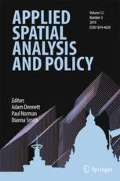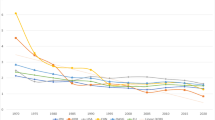Abstract
School consolidation may be an effective policy option in regions where demand for schooling is thin—after taking into account its effects on the school commuting distance, the education quality and economies of scale. The effects of consolidation on the educational quality and the economies of scale have been well researched; but studies on the commuting distance are limited in scope because they usually rely on comparing distances pre- and post-consolidation—which may exaggerate the consolidation’s effect. In this study, optimization approaches are used to decompose school commuting distances at Yanqing, Beijing, based on survey data. The costs of long-distance school commuting as a result of consolidation are estimated after decomposing the effects of school districting, school location and financial stimulation. The findings indicate that these factors contribute significantly to pupils’ long travel distance, and the negative effect of consolidation on school size standardization is exaggerated. These results imply that long-distance school commuting should not be the rationale for a suspension of the central government’s consolidation policy.





Similar content being viewed by others
References
Allen, R. (2007). Allocating pupils to their nearest secondary school: The consequences for social and ability stratification. Urban Studies, 44(44), 751–770.
Andersson, E., Bo, M., & Östh, J. (2012). Travel-to-school distances in Sweden 2000–2006: Changing school geography with equality implications. Journal of Transport Geography, 23(3), 35–43.
Berry, C. (2004). School inflation: Did the 20th-century growth in school size improve education? Education Next, 4(4), 56–62.
Chen, X., Yi, H., Zhang, L., Mo, D., Chu, J., & Rozelle, S. (2014). Do poor students benefit from China's merger program? Transfer path and educational performance. Asia Pacific Journal of Education, 34(1), 15–35.
Church, R. L., & Murray, A. T. (1993). Modeling school utilization and consolidation. Journal of Urban Planning and Development, 119(1), 23–38.
Dumreicher, H. (2008). Chinese villages and their sustainable future: The European Union-China-research project “SUCCESS”. Journal of Environmental Management, 87(2), 204–215.
Giesen, R., Mandujano, P., & Ferrer, J. C. (2012). Model for optimization of locations of schools and student transportation in rural areas. Transportation Research Record Journal of the Transportation Research Board, 2283(2283), 74–80.
Goeverden, C. D. V., & Boer, E. D. (2013). School travel behaviour in the Netherlands and Flanders. Transport Policy, 26(1), 73–84.
Hamnett, C., & Butler, T. (2013). Distance, education and inequality. Comparative Education, 49(3), 317–330.
Hanley, P. F. (2007). Transportation cost changes with statewide school district consolidation. Socio-Economic Planning Sciences, 41(2), 163–179.
Hodgson, S., Namdeo, A., Araujo-Soares, V., & Pless-Mulloli, T. (2012). Towards an interdisciplinary science of transport and health: A case study on school travel. Journal of Transport Geography, 21(1), 70–79.
Howley, C., Johnson, J., & Petrie, J. (2011). Consolidation of schools and districts: What the research says and what it means (p. 28). Boulder: National Education Policy Center.
Hu, Y., & Wang, F. (2015). Decomposing excess commuting: A Monte Carlo simulation approach. Journal of Transport Geography, 44, 43–52.
Lemberg, D. S., & Church, R. L. (2000). The school boundary stability problem over time. Socio-Economic Planning Sciences, 34(3), 159–176.
Li, L., & Liu, H. (2014). Primary school availability and middle school education in rural China. Labour Economics, 28, 24–40.
Lin, J. J., Huang, Y. C., & Ho, C. L. (2014). School accessibility and academic achievement in a rural area of Taiwan. Children's Geographies, 12(2), 232–248.
Liu, C., Zhang, L., Luo, R., Rozelle, S., & Loyalka, P. (2010). The effect of primary school mergers on academic performance of students in rural China. International Journal of Educational Development, 30(6), 570–585.
Maxfield, D. W. (1972). Spatial planning of school districts. Annals of the Association of American Geographers, 62(4), 582–590.
McDonald, N. C. (2010). School siting. Journal of the American Planning Association, 76(2), 184–198.
Mei, H., Jiang, Q., Xiang, Y., & Song, X. (2015). School consolidation: Whither China's rural education? Asian Social Work and Policy Review, 9(2), 138–150.
Mo, D., Yi, H., Zhang, L., Shi, Y., Rozelle, S., & Medina, A. (2012). Transfer paths and academic performance: The primary school merger program in china. International Journal of Educational Development, 32(3), 423–431.
MOF(Ministry of Finance) (2003). Regulations on the special funds for the re-distribution of primary and secondary schools (Financial Education No.[2003]47). Retrieved from: http://www.mof.gov.cn/zhengwuxinxi/caizhengwengao/caizhengbuwengao2001/caizhengbuwengao200111/200805/t20080519_21424.html. Accessed 1 Dec 2016.
MOF(Ministry of Finance)., & MOE(Ministry of Education) (2004). Advices on further strengthening the work of "two basics" in rural area (No.[2004]4). Retrieved from: http://www.moe.edu.cn/s78/A06/jcys_left/moe_706/s3321/201001/t20100128_81822.html. Accessed 1 Dec 2016.
MOHURD(Ministry of Housing and Urban-Rural Development)., & NDRC(National Development and Reform Commission) (2008). Standards for the construction of rural ordinary primary and secondary schools. construction standard 109–2008. China. Retrieved from: http://www.hdjyw.cn/html/201609/3187.html. Accessed 1 Dec 2016.
Nasir, N., & Shariff, S. S. R. (2014). Using hierarchical P-median problem for public school allocation. AIP Conference Proceedings, 1613(1), 420–426.
Ndiaye, F., Ndiaye, B. M., & Ly, I. (2012). Application of the p-median problem in school allocation. American Journal of Operations Research, 2(2), 253–259.
Pizzolato, N. (1994). A heuristic for large-size p-median location problems with application to school location. Annals of Operations Research, 50(1), 473–485.
State Council of China (1986). Advices on the implementation of the "Compulsory Education Law" (No. [1986]69).Retrieved from: http://www.moe.edu.cn/publicfiles/business/htmlfiles/moe/moe_619/200606/15687.html. Accessed 1 Dec 2016.
State Council of China (2001a). Decision on the reform and development of basic education (No. [2001]21). Retrieved from: http://www.moe.edu.cn/publicfiles/business/htmlfiles/moe/moe_16/200105/132.html. Accessed 1 Dec 2016.
State Council of China (2001b). Notice on further reform of rural tax and fee reform (No. [2001]5). Retrieved from: http://www.gov.cn/zhengce/content/2016-09/18/content_5109014.htm. Accessed 1 Dec 2016.
State Council of China (2012). Advices on standardizing the rural compulsory education school layout adjustment (No. [2012]48). Retrieved from: http://www.gov.cn/zwgk/2012-09/07/content_2218779.htm. Accessed 1 Dec 2016.
The former State Education Commission of China (1987). Advices on setting the standards, implementation steps and statistical indicators on compulsory education development. Retrieved from: http://www.moe.edu.cn/s78/A02/moe_627/201108/t20110816_123320.html. Accessed 1 Dec 2016.
Tong, D., & Murray, A. T. (2012). Spatial optimization in geography. Annals of the Association of American Geographers, 102(6), 1290–1309.
Twenty first Century Education Research Institute. (2013). Where does the China's rural education go: The evaluation and reflection on rural school consolidation policy (in Chinese). Beijing: Beijing Institute of Technology Press.
Author information
Authors and Affiliations
Corresponding author
Rights and permissions
About this article
Cite this article
Dai, Tq., Wang, L., Zhang, Yc. et al. The Cost of School Consolidation Policy: Implications from Decomposing School Commuting Distances in Yanqing, Beijing. Appl. Spatial Analysis 12, 191–204 (2019). https://doi.org/10.1007/s12061-017-9238-2
Received:
Accepted:
Published:
Issue Date:
DOI: https://doi.org/10.1007/s12061-017-9238-2




